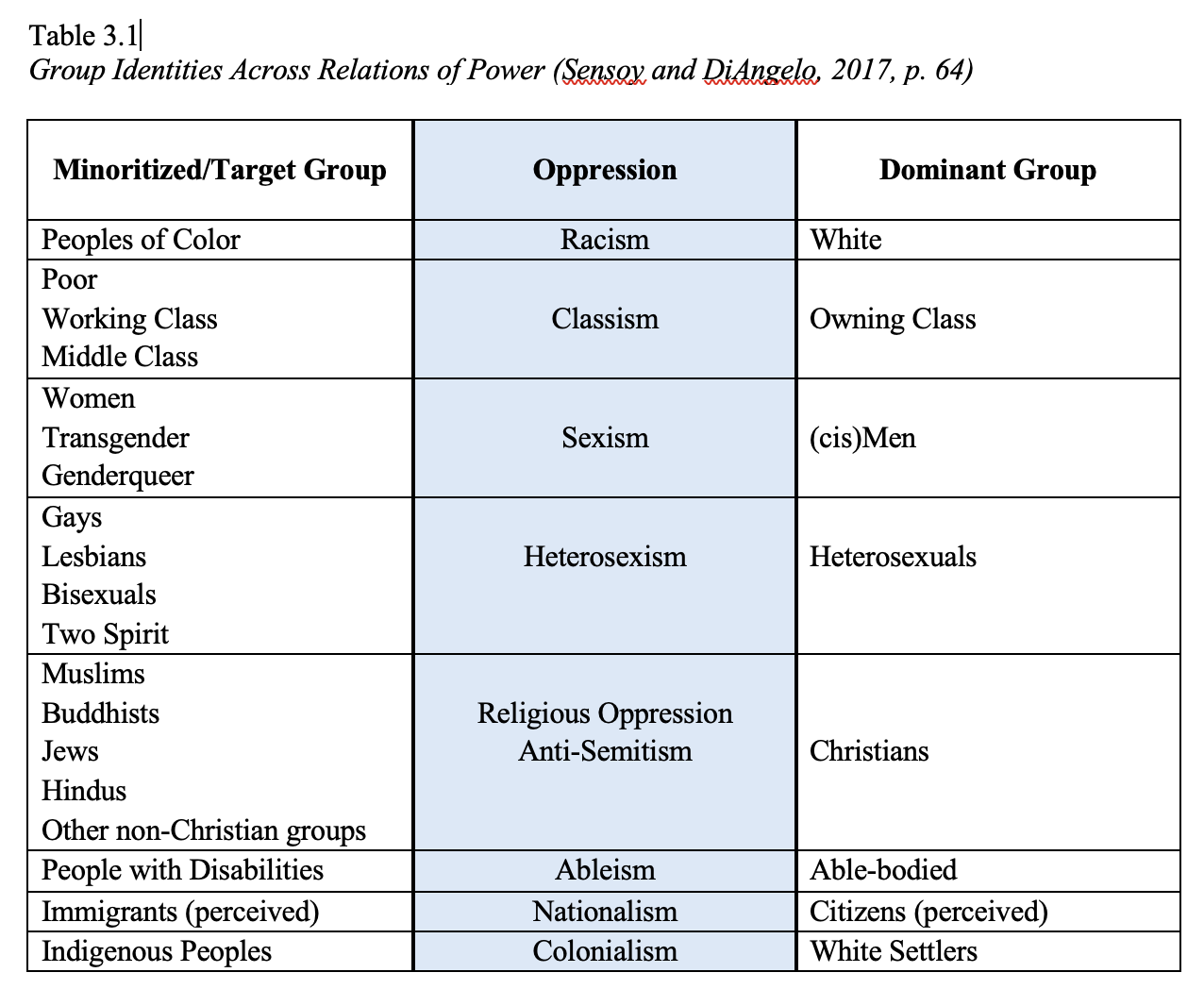Theme 2: Oppressor Groups Have Power Over Oppressed Groups (Part 16)
Excerpt from, “From social justice warrior to Gospel-centered servant of God: An educator’s reflection on critical theory and Christianity” (Linkletter, 2021).
Oppression can be defined as “the systemic and pervasive nature of social inequality throughout social institutions as well as embedded within individual consciousness. Oppression fuses institutional and systemic discrimination, personal bias, bigotry and social prejudice in a complex web of relationships and structures that saturate most aspects of life in our society” (Educate Not Indoctrinate, 2020).
Bob Mullaly describes oppression as the flip side of privilege, which can be understood as the benefits one group receives at the expense of another group due to how economic and political power is organized in a society (Bell et al. 2017).
Critical theory identifies social groups as either oppressed or oppressing by believing they are binary: you are either in one group or another. A visual representation of this concept is in the table below (Table 3.1) which outlines various social descriptors that critical theorists use and the binary groups that are associated with each descriptor.
It is important to also make the distinction between oppression, prejudice and
discrimination.
Prejudice and discrimination take place at an individual level and oppression
takes place in a larger scale when “one group’s prejudice is backed by legal authority and
historical, social and institutional power” (Sensoy & DiAngelo, 2017, p. 62).
Because of its large scale and nature, oppression goes hand-in-hand with power.
Paulo Friere (2018) writes about education as a power system that practices oppression:
“It is necessary for the oppressors to approach the people in order, via subjugation, to keep them passive…by the oppressors’ depositing myths indispensable to the preservation of the status quo: for examples,
the myth that the oppressive order is a ‘free society’;
the myth that all persons are free to work where they wish…
the myth that this order respects human rights and is therefore worthy of esteem…
the myth that rebellion is a sin against God;
the myth of private property as fundamental to personal human development.” (pp. 139-140)
Power plays itself out in social stratification and the world of ‘isms. Social stratification is the concept that each social group has a different, unequal, value and are therefore stratified, which leads to a hierarchy. Figure 3.1 demonstrates how each group has different value and the higher valued are considered oppressors (with more power) (Sensoy & DiAngelo, 2017, p. 63).
Our culture is currently saturated with ‘isms’. Words like racism, sexism, classism, heterosexism, and ableism do not describe individual acts of discrimination, but rather, they describe the oppression that takes place via “unequal social and institutional power between dominant and minoritized groups.” Because oppression is defined on a large scale (historical, embedded, and pervasive) and not deduced to individual acts and choices, ‘isms’ cannot be reversed over time or between different situations and within different relationships; “the same groups who have historically held institutional power in the United States and Canada continue to do so” (Sensoy & DiAngelo, 2017, p. 66).
In Canada, settlers came to escape oppression and simply changed places once they arrived, becoming the oppressors. Therefore, building oppression into the “very fabric of the Americas” and making it hard to reverse over time (Bell et al., 2017, p. 12). Canada has numerous injustices that can be sorted into six categories:
colonial privilege,
racism and privilege,
class privilege,
patriarchal privilege,
heterosexual/cisgender privilege,
and ableism and privilege (Bell et al., 2017, pp. 29 – 47).
These categories are included in figure 3.1 which further demonstrates how critical theorists do believe that people are identified by their social groups and those social groups fall within either the oppressed or oppressor category.
In the essay titled, “Age, Race, Class and Sex: Women Redefining Difference” Audre Lorde (2007) explains how the differences in our social groups separate us from one another and mean we have no way of relating across our differences. She writes:
Racism, the belief in the inherent superiority of one race over all the others and thereby the right to dominance. Sexism, the belief in the inherent superiority of one sex over the other and thereby the right to dominance. Ageism. Heterosexism. Elitism. Classism…We have all been raised in a society where those distortions were endemic within our living. Too often, we pour the energy needed for recognizing and exploring differences into pretending those differences are insurmountable barriers, or that they do not exist at all…In America [the] norm is usually defined as white, thin, male, young, heterosexual, Christian and financially secure. It is with this mythical norm that the trappings of power reside within this society. (Andersen & Collins, 2020, p. 12)
This quote demonstrates how critical theorists identify people by their social groups and categorize those groups into a hierarchy of oppressed vs. oppressor. These notions of oppressed vs. oppressor are laced throughout much of the literature and media published by critical theorists. It is sometimes clearly laid out like in the quote above, but it is most often noticed in the language.
It is my opinion that oppression cannot be defined and labelled according to physical descriptors (race, class, gender). In chapter four of this research paper, I will reflect on oppression from my biblical worldview and discuss how it can be defined and understood through scripture.
Rebecca
References
Andersen, Margaret L., & Collins, Patricia Hill. (2020). Race, class, & gender: Intersections and inequalities (Tenth Edition). Cengage Learning Inc.
(Bell), Banakonda Kennedy-Kish., Sinclair, Raven., Carniol, Ben., & Baines, Donna. (2017). Case critical: Social services and social justice in Canada (Seventh Edition). Toronto: Between the Lines.
Educate not indoctrinate. (2020). Race equity glossary of terms. https://educatenotindoctrinate.org/race-equity-glossary-of-terms/
Friere, Paulo. (2018). Pedagogy of the oppressed. Bloomsbury Academic.
Lorde, Audre. (2007). “Age, Race, Class, and Sex.” Sister Outsider. Crossing Press, Random House Inc.
Sensoy, Ö. & DiAngelo, R. J. (2017). Is everyone really equal?: An introduction to key concept in social justice education. New York: Teachers College Press.\



